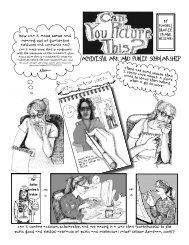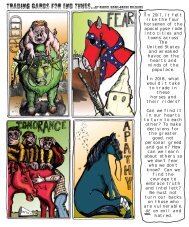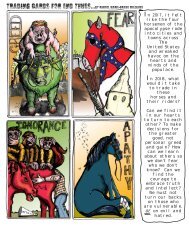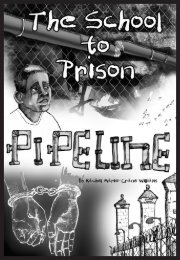Girls In the System
This zine was made in conjunction with the Hull House in Chicago, the Chicago Freedom School, and Project NIA
This zine was made in conjunction with the Hull House in Chicago, the Chicago Freedom School, and Project NIA
You also want an ePaper? Increase the reach of your titles
YUMPU automatically turns print PDFs into web optimized ePapers that Google loves.
A story about young women &
the juvenile justice system
By: Rachel Marie-Crane Williams
This zine series was made in connection with “Unfinished Business–Juvenile
Justice,” the community-curated exhibit at the Jane Addams Hull-House
Museum, on view through August 2011.
“Unfinished Business” is curated in collaboration with over a dozen
community partners and makes connections between the founding of the
nation’s first Juvenile Court in 1899 and the pressing contemporary issues
of juvenile justice and prison reform. The exhibit fosters dialogue and provides
opportunities for visitors to participate onsite in several forms of civic
engagement. While much progress has been made on the issue about which
Jane Addams and other Hull-House reformers cared so deeply, we wanted
visitors to know that there is still a lot of “unfinished business.” The work of
creating a more just society continues, and we can all be part of transformative
social change.
These zines—created in collaboration with Project NIA; the Chicago
Freedom School; teaching artists Rachel Marie Crane-Williams and Elgin-
Bokari T. Smith; artist and activist Billy Dee; and youth inside and outside
the system—attempt to create a critical awareness of the issues by addressing
the many facets of juvenile justice.
Five zines speak to the History of the Juvenile Court, Girls in the
System, Youth Voices (of the Incarcerated), the School-to-Prison Pipeline,
and the Prison-Industrial Complex. Through dialogue and creative thinking,
we believe that a series of zines allows us to become a more effective public
history site and enables us to contribute to popular education in a unique
way. These zines challenge preconceived notions, stir our imaginations, and
generate new community beyond the Museum’s walls.
So, what is a zine? Fanzines or “zines” are do-it-yourself (DIY) minibooks
that have a long history of communicating openly, honestly, and plainly.
Zines are independent and capture the spirit of a localized scene, but are
meant to have far-reaching effects. Once you read a zine, pass it along to
a friend or acquaintance. By sharing and discussing zines, the community
grows, and you’ve made a valuable connection with someone.
The Jane Addams Hull-House Museum serves as a dynamic memorial to
Nobel Peace Prize recipient Jane Addams and other resident social reformers
whose work influenced the lives of their immigrant neighbors as well as
national and international public policy.
The Museum preserves and develops the original Hull-House site for
the interpretation and continuation of the historic settlement house vision,
linking research, education, and social engagement.The zine series is a valuable
tool for civic engagement and emphasizes that “history is not a spectator
sport” but something that everyone can and should be engaged in making
at all times.
Want to find out more or get involved? Check us out and download
copies of the zines at: www.hullhousemuseum.org
--Teresa Silva, community curator of “Unfinished Business–Juvenile Justice,”
Jane Addams Hull-House Museum, 2011
After over a year of work, I am thrilled to announce the publication
of a series of zines about the juvenile justice and prison systems. This collaborative
experience was a truly rewarding and wonderful one. When I approached
my friend Lisa Lee, of the Jane Addams Hull House Museum, with
the idea of creating a graphic novel about the history and current manifestations
of juvenile justice, I could not have imagined where we’d end up today.
We both agreed that this project would only make sense if we centered
the voices of incarcerated youth as well as young people on the outside.
We knew that we wanted to find partners who would share our vision and
would have the skills to execute it. We were incredibly lucky to find talented
and dedicated teaching artists like Rachel Williams and Elgin Smith to work
with on this project. Both of them collaborated respectfully with the young
people who participated in what would eventually come to be known as our
“cradle to prison pipeline” comic arts project. After that, they spent countless
hours drawing and authoring the zines that we are releasing today. If we had
paid them what they are worth, we would all be bankrupt.
We were also blessed to partner with the Chicago Freedom School
which provided a meeting space for youth and with Eva Nagao, Freedom
School board co-chair, who took it upon herself to recruit young people for
this project. Eva handled all of the logistics for the 5 weeks of the comic arts
program for youth on the outside. Special thanks also to Rachel Shine who
volunteered her time with the youth as they learned about juvenile justice
and drew their own images.
The Cook County Juvenile Temporary Detention Center (JTDC)
welcomed us for 4 weeks in August 2010 to work with the young people who
were incarcerated there. Teaching artist Elgin Smith, who already works at
JTDC, led comic arts workshops for both girls and boys at the jail. We are
indebted to the youth for sharing their stories and talents with us.
As an added bonus, artist and activist Billy Dee, working with
members of the Chicago PIC Teaching Collective, has created a zine about
the prison industrial complex that the Museum has generously printed too.
There is no way that anyone who looks at the “PIC Is” zine will miss Billy’s
talent or huge heart. Both are apparent throughout the publication.
This project would not have been as seamless or as enjoyable as it
was without the presence and guidance of Teresa Silva. Teresa’s steady hand
and her soft touch moved us along and helped bring the project to completion.
Thanks to Teresa for all of her contributions.
There are few people in the world as unique and inspiring as Lisa
Lee. Over the years, Lisa has fostered opportunities for youth and adults
across Chicago to learn about history, art, and social justice. She does this
without fanfare but always with unmatched generosity of spirit. This project
would not have happened without her. I am eternally grateful to Lisa for all
that she has done and will undoubtedly continue to do in the future.
Finally, a point of personal privilege… I am committed to using
art as a tool for social transformation and justice. I believe that art has the
capacity to speak across difference and to help educate and incite people to
action. I hope that those individuals who read these zines come away asking
the question: How can I contribute to dismantling the prison industrial complex?
If even only one person asks, then we will have done our part.
In Peace and Solidarity,
Mariame Kaba, Director, Project NIA
Girls represent 15% of youth incarcerated in the U.S. juvenile justice system
Ask someone to
imagine a Youth in
trouble...
and the image they conjure is not
usually a girl.
My name is Janette, I am
15. A few months ago I
was arrested for the
second time and
sentenced to
spend a year at
Sunnyville Institution
for Girls
for possession of
illegal substances,
and prostitution.
29% of youth who are arrested in the United States are girls
I started having problems when I was a little kid. My
step brother molested and raped me when I was in first
and second grade-He was 14.
After that my Mom
divorced my step-father
and we moved away.
Most girls in the
system have lived a life
Fi lled with family instability,
trauma and abuse.
I really love my
mom but she has
a drug problem--
after the divorce
she kind of fell
apart. She has
been in and out
of jail & treatment
all my life.
But she is a good
mom and she really
loves me. I
haven’t seen her in
two years.
]
I’ve never met my
real father. Once
when I was four
I got a birthday
card from him. It
wasn’t even my
birthday. I still
have the card.
I lived with my mom until I was
10. Then she got picked up for
drugs and social services took
me away from her.
I
love you
Janette!
Girls in the juvenile
justice system often
have troubled family
histories. It is not uncommon
for parents to
have had contact with
the criminal
justice system.
The educational histories of female juvenile offenders areoften f illed with academic failures and poor relationships
Mom!
I
was bounced
around to 9 different
foster families.
Foster care was horrible and so was school.
No matter what school I attended
I always got in trouble, mostly for skipping
and then for smoking. Eventually I started
running away.
Every time I went to a new foster home I changed schools.
Sometimes they sent my records, sometimes they didn’t. When
I get a new case worker I usually have to start all over
telling them where I have been and what has happened at
every school, shelter, group home and foster family.
I
have been here
for 221 days. When
I first came in I had
a cutting “issue”.
One
of the night staff caught
me rubbing my arm with an eraser.
I was bleeding. They put me
on suicide watch. I wasn’t’
trying to kill myself.
"Personal and
family problems and
needs can generate
turmoil for youth, who
may also become lost in a
tangle of
bureaucratic agencies that
too often share only
limited information with each
other, resulting in
fragmented assistance."
-OJJDP (2000)
chew chew
I just needed to cut
myself. Sometimes it
makes me feel
better. I was really
depressed because
I didn’t understand
how long I had to
be here or what was
going to happen
afterward.
girls in the system are often re-traumatized by excessive use of
force by officers and extreme isolation.
Stupid
&^%*#!!
Often juveniles
who cut, scratch
and burn themselves
also
have depression,
substance abuse,
anxiety, and anger
Self- mutilation
offers relief and escape from feelings of sadness or anxiety.
( Garrison et al., 1993 ; Guertin et al., 2001; Walsh and Rosen, 1988 ).
Smack
The first time I was here I
freaked out. Officer Northway
tackled me and then they put me
in isolation for two weeks.
Girls are six times more
likely to develop
Post-Traumatic Stress
Disorder (PTSD) than
boys (CWLA, 2004)
Girls are sometimes over medicated...
When I got out of lock down they put me on “meds”
right away-- supposedly to help me “Cope”. They just
made me feel sleepy and dizzy.
Just to control their behavior.
I left after 6 months. The
state put me in foster
care again. My foster mom
forgot to refill my
prescription so I just quit
taking my pills.
]
I tried to go back to
school but I dropped out
again after three weeks
and ran away. My foster
family treated me different
from their “real” kids.
The father in the foster
family kept looking at me
weird. I felt like if
something happened no
one would believe me so I
ran. I went back to my old
neighborhood and tried to
find my mom.
I moved in with my
mom’s old friend, Jimmy.
He said he would take
care of me and look out
for me. It was cool at
first. I just lived in his
apartment and watched
TV all day. He didn’t
like me to go out or cut
my hair. After a few
months he quit having
sex with me. I guess he
got tired of me. I didn’t
have any where to go
and I was afraid the
child protection people
would be looking for me.
I kept thinking I would
find my mom.
The National Runaway Switchboard estimated that In
2006, there were between 1.3 and 2.8 million runaway
and homeless youths in America.
Jimmy and I started fighting and he hit me
all the time and forced me to have sex with
him. I waited till he went to work, cut my hair
short and left. The first night I slept in a
warehouse.
This
is so scary...
and
brrrrr
Girls who run away are often fleeing sexual abuse and or neglect.
They are forced to engage in survival strategies
for food, shelter, and clothing that are linked to criminal
activity such as trading sex for money, stealing, and panhandling.
Sometimes I would
beg for money. Usually
I could get enough
for fries and a drink.
I would sit in the
booth until they kicked
me out. Then go to
the library or try to
find a warm place to
cry myself to sleep.
I had sex with the man
that picked me up.
When he was
done he gave
me a twenty.
For the
first time in
week I ate
until I was
full.
In one night
everything
changed...
Need
a lift???
After that night my life turned into a blur of men
in cars, drugs, sex, and pain. Selling myself was an
easy way to make money, get food or get high...
by November I wanted to die.
there were an estimated 1,450 arrests/detentions for juvenile
prostitution in the United States in 2005; 90% of those arrested
were girls. 60% had histories as runaways. (Mitchell, Finklehor, and
Wolak, 2009)
Then me and two other girls got arrested. We were
working together, sometimes we could make more
money that way; it was safer too. We were set up by
plain clothes cops. I had drugs in my bag too.
Tony,
she left her
backpack in the
car--check it
out!
My case was referred
to the juvenile court.
I went through intake
with a juvenile court
officer and he decided
to petition the
case because I had
a record already and
also because I was a
runaway and a ward
of the state. I was
found by a judge to
be delinquent.
No!!
Janette, this is the
second time... You are
very lucky that you are only
15. I hope we don’t meet
here again.
The way police respond to juvenile sex workers determines if
they are seen by the system as victims or delinquents.
(Mitchell, Finkelhor, Wolak, 2010)
Me
too. I really miss
my family.
I
hate being
here...
That is how I
got to Sunnyville
the second time.
I really miss
being free. I
hate wearing a
uniform and
having to obey
so many rules to
“make my levels”
and stuff.
]
The only really
good thing about
being locked up
is my roommate
Olivia. She’s 16.
Olivia has been
locked up at
Sunnyville for
almost a year.
She has an
8-month oldbaby.
Approximately 10% of girls are pregnant
when they enter the juvenile justice system.
Only 40% reported that they experienced
pregnancy and/ or delivery with
no obstetric complications. Researchers
found that only 69% of detention facilities
provided prenatal services on site
and 30% provided parenting classes.
I
wish the baby would
settle down just a bit so I could get
some rest. It keeps kicking.
Olivia
was 6
months
pregnant when
she came to
Sunnyville.
She gave her mom the baby. Olivia is trying to be good so
she can go home early. She’s even earned her GED. Olivia
seems so strong and together. She’s been through so much
6 months later...
So
Janette... I am
here to help make a
plan for when you
are released
We
think a group home
might be best since
foster care hasn’t
suited you.
What
about my mom?
Teen mothers usually live in poverty. Their daughters are much
more likely to become adolescent mothers themselves, and
the sons of teen age mothers are 2.7 times more likely to become
incarcerated (Greene & Peters, 1998).
I got another
new case worker.
I am scared to
leave, but I don’t
want to stay
either. I don’t
really have any
family; no school
will take me because
I am so
behind. My old
neighborhood is
filled with drugs.
What will happen?
3 months later... I am still living in a
group home but I’m not in
school. I found a job at
a grocery store around
the corner bagging groceries
and stocking
shelves. It sucks. I
Sorry, Umm...I
thought you said
Paper.
only have a few
more months
in the group
home. When I
turn17 they are
going to transition
me to independent living.
]
I quit taking my pills. I
can’t afford the
prescription and I don’t
need them. Sometimes, I
still have nightmares and
get scared. I started
cutting again, no one
knows. I just want to
feel safe and secure. I
am just trying to survive.
Rena works with me at the store. She is on parole.
I
am sick of it...
I feel like I
can never
move on.
Initially Probabtion and parole were treatment centered. This
attitude has given way to one more
concerned with surveillance.
Just checking
(Petersilia, 2003).
in with you Rena. I heard you
weren’t at work today.
He makes me go to all these groups. I feel like I
am still locked up at Sunnyville. I don’t have any
freedom or privacy.
I
want you to
join this drug
abuse and
recovery
group. It meets
every week.
Rena?
You ok?
Knock
Knock
My parole
officer is
always
snooping around...
I have to take a drug
test every month. Sometimes
he even stands
outside of the bathroom
while I go! I’ve been
clean for 16 months.
The conditions of my parole specify that I have to live
with my Dad even though we don’t get along at all. Last
week he kicked me out again for staying out past my curfew.
I stayed with my friend and went home the next
day. If I don’t live there I have to go back to
Sunny ville. We fight all the time. It is really stressful.
JERK!
GET
OUT!!!
Mike
I have never
lived with my
father until now.
He was trying
to be nice when
I got out. The
court thought his
house would be
good because his
wife stays home
and they have
two boys. They
look like the perfect
family. I
just don’t fit into
their lives. Last
summer I went
on vacation with them. It was a disaster. Now I
am stuck with them until I am twenty-one or go
back to court. It doesn’t seem fair.
One night on a break from
stocking shelves...
Really?
I
am going to stay clean
and try living on my
own...
I’m
going to
start taking
classes
Rena
What
about you
Janette? What
are you going to
do?
What can we do to change the way that girls are
treated by the Juvenile Justice system?
I am
just going to take
life one day
at a time...
Question why girls are incarcerated for less
serious offenses than boys
Demand Gender-Responsive programming for girls in
custody and treatment
Speak out against practices such as strip searches,
isolation and restraint which have the potential
to further traumatize girls in the system
Agitate for interventions and treatments that address issues
such as abuse, violence, family relationships, substance abuse,
and co-occurring disorders in girls
Require that schools, social services, corrections, and aftercare
service providers share information and cooperate to form
a communication web so girls don't fall through the cracks
Expose the ways in which our justice system is used
as a mechanism of social control against
minority youth, girls, and people who are poor.
Remember Girls are resilient: build on their strengths
Mentor a girl in Need
A product of The Cradle to Prison Pipeline Project
Sponsored by the Jane Addams Hull House Museum; College
of Architecture and the Arts, University of Illinois
at Chicago; The Chicago Freedom School,
and ProJect NIA
2011
A Special thanks to the Chicago Freedom School
Students, Mariame Kaba, Lisa Lee, Teresa Silva, Eva NagAO,
Rachel Shine, Sean Kelley, and Elgin Smith
for more information go to:
http://chicagofreedomschool.org/
http://www. hullhousemuseum.org
http://www.project-nia.org/










